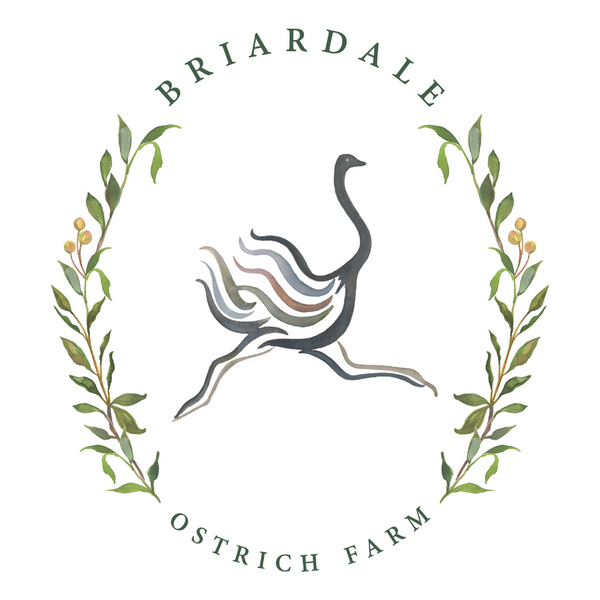What is life like for an ostrich at Briardale?
The life of an ostrich on our farm is a rich one with fresh fields of grass and attentive care. Life starts in the breeder field where our adult ostriches are given a safari-like environment to carry out their natural behaviors. Their eggs are collected daily and taken to our incubator facility. After about 42 days of incubation, the ostrich chicks hatch out and are moved to our nursery. They’ll spend the first 2-3 weeks of life in the nursery before they’re moved to outside pens, our goal is to get them on fresh grass as early as possible. From there they will continue to grow at a rate of about a foot a month for the first 10 months before growth slows down, enjoying ample feed & sunshine along the way. Our birds are then processed between 10-14 months of age to assure the tastiest and highest quality products available on the market.


About our Operation:
- Our ostriches are bred, layed, incubated, hatched, raised, slaughtered and processed all on our 326 acre farm in Okeechobee, Florida!
- The same day our birds hatch, they have access to an outdoor run and are living entirely outdoors on pasture by 2 weeks of age.
- Our pastures are 90-100% vegetation, consisting of argentine bahia in the summer. In the fall when the pasture becomes dormant, we overseed using a no-till drill with oat, annual ryegrass and clover.
- In the summertime, we also grow millet and sun hemp to mix into the feed.
- Ostriches are among the hardiest animals in the world with a 65 million year old immune system. Because of this they not only fare very well outdoors, but they do not require any antibiotics or hormones!
Health Benefits:
- Not only is ostrich meat incredibly tender and tasty, the filets comparable to beef filet mignon, but it is also the healthiest red meat available on the market.
- Ostrich meat has a similar taste, texture and coloring to beef but has only 1/3 of the fat and 40% less cholesterol, making it a far more heart healthy option.
- Ostrich contains more iron than beef
- Because of their highly developed, prehistoric immune systems, no antibiotics are required.
Sustainability:
- Ostrich require far less natural resources than beef:
- 1/3 of the water
- 1/50 of the land
- Unlike cattle and other livestock, ostriches emit very little greenhouse gasses and methane, 1/10 of what cattle produce.
- We are constantly working to optimize our operations by using regenerative farming practices.
- Every grass we plant is a soil builder and the ostriches are rotated to different pastures weekly with the excess grass leftover green chopped into their feed.
Fun facts about ostriches in the wild:
The ostriches coloration is believed to be designed to make hatching eggs a successful process. The females are a color almost identical to sand to more easily hide from predators while incubating nests during the day. The males, however, are black because they incubate the eggs during the night time.
When hatching, sometimes the chicks will have difficulty breaking through their shell in a process called “pipping”. When this occurs, the ostrich will use its legs to break the shell open and assist the chick.
Ostriches are considered a living dinosaur, they are the largest bird in the world as well as the only two toed bird in the world


